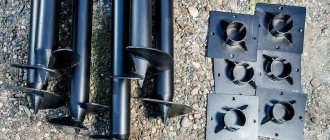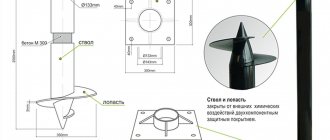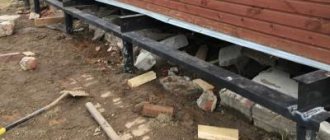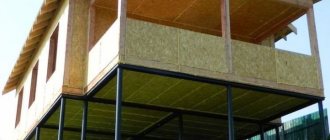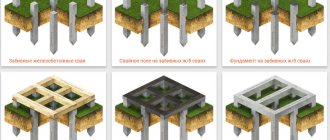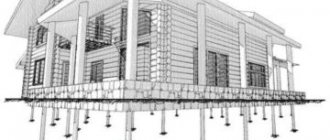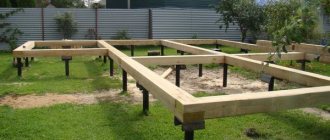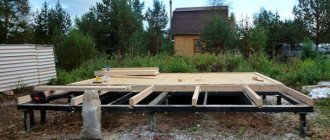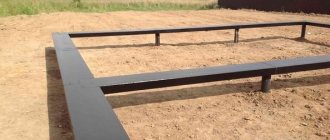With the efforts of 2 – 3 people, without the use of special equipment, you can build a strong and reliable foundation for a bathhouse, country house or other building within a few days.
If you have minimal experience and follow the rules below, self-construction of a pile-screw foundation (SVF) will not cause any particular difficulties.
Rules for installing a pile-screw foundation
Independent construction of the foundation of a building or structure from a foundation on screw piles (SP) is based on compliance with a fairly simple technology.
To successfully install a pile-screw foundation with your own hands, you should adhere to the following rules:
- the support is screwed into the soil strictly vertically. Any deviations to the side damage the load-bearing capacity of the SVF;
- the outer surface of the aircraft must be subjected to anti-corrosion treatment;
- the barrel cavity with an open lower end must also be covered with a protective compound. Otherwise, wet soil will cause metal corrosion;
- the soil base should not contain coarse and rocky rocks;
- The ends of the piles must be located below the frost line and above the groundwater level. This is necessary so that heaving forces caused by seasonal changes in soil temperature and changes in the water horizon cannot push the pile upward;
- the lower end of the support should not be open; it is welded with metal in the form of an ellipse at an angle of 450 or a cone. The concrete inside the barrel will protect the steel from corrosion;
- regardless of the estimated number of piles, an interval of 1.5 - 2 m is maintained between them;
- Installation of SVF is carried out by at least three people. Two workers rotate the aircraft using levers threaded through the top mounting holes of the pile. The third person uses his hands to hold the pipe in a vertical position.
Advantages of using screw piles
The popularity of using screw piles is determined by the following advantages:
- efficiency;
- security;
- reliability;
- environmental friendliness;
- quick installation;
- high seismic resistance;
- mobility;
- versatility.
Screw piles are very practical; they can be installed at any time of the year, regardless of weather conditions. The use of screw piles is a proven, effective technology that can be used to create a strong and reliable structure.
Principles of calculation and design
The pile-screw technology for constructing foundations is based on the principle of passing a point support through weak layers of soil to dense bearing layers.
The load from the house is thus transferred directly to the load-bearing soil foundation, which ensures a reliable and durable position of the structure.
The depth of the load-bearing soil layers is determined by experimental drilling and taking soil samples, followed by their testing. This parameter is also taken from a vertical survey linked to the construction site, which is available in every architecture department of the local executive committee.
By collecting loads (the weight of all building structures, furniture, equipment for various purposes, the maximum number of people, etc., snow load) and dividing them by the total area of the screw piles, the specific pressure on the soil is determined . It should be less than the resistance of the load-bearing soil layer. This ratio is used to adjust the number of screw piles on the SVF plan.
Based on the number of piles, the type of supporting soil layer and the factory data on the load-bearing capacity of standard screw piles, the type and brand of aircraft is determined.
The versatility and quick installation of SVF attracts many developers to build foundations not only in places where heaving soils are located, but also on quite strong load-bearing foundations. The only exception is rocky soils, which, with their solid inclusions, can damage and completely destroy the blades of screw piles.
There are standards for selecting standard sizes of piles for the construction of various objects . The main indicator is the diameter of the support trunk, which is directly related to the magnitude of its load-bearing capacity. For manual installation of piles, supports with a diameter of 57 to 133 mm are used.
| Pile diameter, mm | Load, kg | Soil type | Structure |
| 57 | 800 | Waterlogged soil | Lightweight frame buildings |
| 89 | 1400 | Swampy and peat bogs | Country houses, garages |
| 108 | 3500 | Everything except the rocky ones | Log houses (log houses) |
The length of the pile is calculated based on the fact that its lower end must be immersed in the load-bearing soil layer by at least 300 mm. To this add the height of the ground part of the support. The construction project specifies the amount of clearance between the ground and the aircraft frame (grillage).
The minimum technological gap allowed is 150 mm high . Here you should add the distance to the technological holes + 100 mm. In total, this will be the optimal length of the pile.
Practical experience shows the advisability of manual installation of screw supports with a length of up to 1.8 m. For larger sizes, installation of SVF is possible only with the help of special equipment.
How to draw up a drawing of a pile field?
After all the calculations, they begin to create a drawing of the aircraft location on the construction site plan.
When placing supports on a personal plot, the following rules are followed:
- Piles should be installed at all corners of the foundation plan.
- Supports for a monolithic slab for equipment (furnace, boiler, etc.) will be in the corners and along the perimeter every 1.5 m.
- Along the axes of the load-bearing walls, the centers of the piles are placed at intervals of 1.5 to 2 m, depending on the material of the grillage (framing). For example, for a beam - 1.5 m, and for a channel it will be enough to install supports every 2 - 2.5 m.
An example of an as-built diagram and plan of a pile-screw foundation:
Area of use of driven piles
Reinforced concrete driven piles
Installation of driven piles is carried out using special hammers without excavation and soil excavation. They are also immersed in the ground by washing, pressing and screwing. The use of pile drivers and pile driving machines makes it possible to install a base for a foundation with a length of 8 to 90 m. Depending on the materials, wooden, metal and reinforced concrete driven piles are distinguished. Wooden elements are made from coniferous trees and are used on soft soils for the construction of objects with low load on the base. To protect against fungus and moisture, they can be treated with special compounds. The scope of application of metal driven piles is complex hard soils and uneven terrain with significant differences. For their manufacture, rolled steel is used in the form of profiles or pipes with a length of 20 to 30 m.
Another option is factory-produced reinforced concrete products. By design they are:
- In the form of prisms with longitudinal reinforcement. Such piles are used in sandy loams, loose and medium-density sands, loams and clayey areas. Structures used to construct the foundation must be completely immersed in the soil or located inside heated rooms.
- With a square section with a round cavity and composite with transverse reinforcement and a solid square section. Such piles are used for various types of structures in areas with sandy or clay soil, except for hydraulic facilities.
- Hollow round and shell piles. Their use makes it possible to construct buildings under the influence of significant vertical and horizontal loads, including in areas with increased seismic activity. Restrictions apply to construction on peat bogs, silt and clay soils.
When constructing buildings on driven reinforced concrete piles in subsidence soils, provision should be made for their complete cutting and securing of the lower ends in non-subsidence soils.
Selection of piles
To install SVF on a personal plot, you should purchase piles that meet the conditions for their installation.
Which ones are best suited for private construction?
Different manufacturers are guided by their own specifications when manufacturing screw piles. They can be equipped with one, two or more blades and be of different lengths. For the construction of country houses, garages and other ancillary structures, aircraft with a diameter of 89–133 mm with one or two blades are used.
How to check the quality of items?
When purchasing screw piles, you need to pay attention to the anti-corrosion treatment of the barrel and blades. You need to run the edge of the coin along the surface of the support. If the white color of the metal does not appear, then the coating is considered to be of high quality.
For home construction, standardized screw piles are used, in which the outreach of the blades is interrelated with the diameter of the trunk. The bottom picture shows the proportional dependence of these quantities.
Any discrepancy between them is considered poor quality of the foundation shell and is subject to rejection. The pipe wall thickness must be at least 4 mm .
You can check the size with a caliper. This provides rigidity to the pile, which prevents the trunk from deforming during installation and operation of the building’s base.
Application of piles
Screw piles consist of a shaft in the form of a round metal pipe and a blade, the area of which varies slightly. It is the blade that is then twisted into the ground and carries a much greater load than a conventional pile, due to its large area. Foundations that use such structures are considered much more reliable and durable. The use of such technology using screw piles is especially suitable for:
- construction of fences;
- creation of signs, billboards, signs;
- installation of supports for pillars;
- construction of houses, sports facilities, garages, greenhouses;
- construction of berths, passages and bridges;
- strengthening and reconstruction of the foundation, etc.
As you can see, the range of uses for screw piles is very wide, and therefore the technology is in demand. In many cases, screwing in screw piles becomes the only possible option, especially in places where the soil is unstable and it is not possible to pour a conventional foundation.
How to install it yourself: step-by-step instructions
This instruction is not a dogma, but is purely advisory in nature. You should pay attention to some key points, the fulfillment of which is mandatory.
Tools and materials
Before starting work, prepare the following tools and materials:
- garden auger;
- mortar mixer;
- shovels;
- magnetic level;
- Angle Grinder;
- laser level;
- sections of water pipes from 2 to 3 meters long;
- mounting nozzle;
- screw piles;
- heads;
- electric welding.
Preparation
Debris is removed from the construction site and, if possible, vegetation and fertile soil layer (100 - 150 mm) are removed.
Next, perform the following steps:
- Using a cord and pegs, the plan of the pile-screw foundation is transferred to the site.
- At the points where the corner supports are marked, pits with a depth of 300 mm are made with a garden drill.
- The correct construction of marking rectangles is checked by the equality of the diagonals between opposite corners, measuring them with a cord.
- On straight sections of marking lines, pits are also drilled for supports. The diameter of the pit should be such that the screw fits tightly into it. This is necessary to accurately adjust the initial vertical position of the aircraft.
How to screw it in correctly?
Having prepared the pile field, they proceed directly to the installation of piles. In order to properly tighten the supports yourself, you can use one of three methods:
- The installation process involves 2 people. One, having threaded the lever into the mounting hole, rotates the pile around its axis, and the second holds the support in a vertical position with both hands. This method is effective when the foundation depth is no more than 1.5 m and the trunk diameter is 57 mm.
- The aircraft is assembled by three people. Two workers, inserting pieces of pipe into the upper end of the pile from opposite sides, move around clockwise. The third worker controls the smooth entry of the pile perpendicular to the horizon.
- The third method is to use a mounting head, which is placed on the top of the pipe and fixed with a piece of pipe through the mounting holes of the support barrel.
On both sides of the head there are loops made of reinforcement, which allow you to thread pipe-levers of any length and diameter through them. This allows you to significantly increase rotational forces and reduce installation time. To control the vertical position of the support, a magnetic level is attached to the barrel. The worker, looking at the position of the device bubble, straightens the position of the pile relative to the horizon and vertical with his hands.
Trimming
Once screwing is complete, begin cutting the piles:
- select the shortest support and make a mark below its holes using a laser level;
- the mark of the above-ground height of the trunk is transferred to all supports using the same level;
- Leveling the height of the SVF relative to the horizontal plane is done by sawing off parts of the pipes above the mark with an angle grinder.
Concreting
The procedure is carried out as follows:
the pile cavities are filled with concrete M 300. It is prepared in a mortar mixer or manually in a suitable container. Cement M 400 - 500, sand and crushed stone are poured into the container in a ratio of 1: 2: 2;- during the mixing process, water is gradually added until a liquid dough-like homogeneous mass is obtained;
- for quick pouring without loss, a homemade watering can, rolled up from a piece of tin, is inserted into the support;
- As the shaft is filled, the concrete is compacted with a piece of reinforcement, squeezing the air out of it.
Heads are put on the upper ends of the aircraft and welded to the piles using electric welding . A grillage metal profile is laid on the head areas. Next, they begin the installation of floors and wall fences.
If you plan to install a grillage from a channel, then immediately after pouring, install the caps. In the case of forming a frame from timber or logs, pieces of reinforcement are placed inside the piles and the concrete is allowed to harden for 10 - 14 days.
Options for building a foundation on metal piles
Grillage options
After installing the metal piles to the zero horizontal level, they proceed to connecting the caps. Depending on how the piles are connected, foundations are divided into several types:
- Using wooden beams. This type of foundation is used in the construction of small frame-panel houses. These can be country houses and garden houses, various extensions to the building that do not require a capital foundation. To fasten the beams, metal headers with holes are used. All pile pipes are connected to each other by beams.
- Channel connections are used in the construction of larger buildings with a large load on the ground. This type of strapping is used in the construction of piers, bridges and in places with high humidity.
- For foundations with reinforced concrete grillage poured, a reinforcing frame is prepared, installed and connected to the caps along the entire perimeter and at the intersections of the partitions inside. After pouring concrete, you will get a single monolithic reinforced concrete strip. Such a foundation is used in the construction of houses made of aerated concrete, cinder blocks, shell rock, and brick houses, since the walls of such structures transfer a significant load not only to the pile foundation, but also to the tape itself.
- Pouring a reinforced concrete slab is the creation of a single integral structure, which ultimately ensures the reliability of the support of the future building. A foundation filled with a reinforced concrete slab will ensure reliability during sudden temperature changes and is a solid foundation when constructed on soft soils.
To make such a foundation, a reinforcing frame is prepared around the perimeter and inside it, connected to the heads of the columns and filled with concrete. This design will not allow a single pile to sag, since the slab works with them as a single whole.
Possible errors, recommendations for the construction of SVF
If you are planning to install a pile-screw foundation with your own hands, it is important for the developer to know how to avoid mistakes during installation:
- Incorrect calculation of the required load-bearing capacity of a point support can lead to destruction of the foundation or unnecessary costs. To avoid miscalculations, it is better to turn to professionals who will make an accurate feasibility study for the construction of the SVF.
- The use of low-quality screw piles will inevitably lead to such sad consequences as uneven subsidence of the structure. It is necessary to purchase piles from trusted manufacturers with a guarantee of product quality.
- If the blades of screw supports enter the freezing zone of the soil base, this can lead to seasonal pushing of the supports out of the soil. If you cannot accurately determine the depth of the pile yourself, it is better to contact a specialized construction organization.
